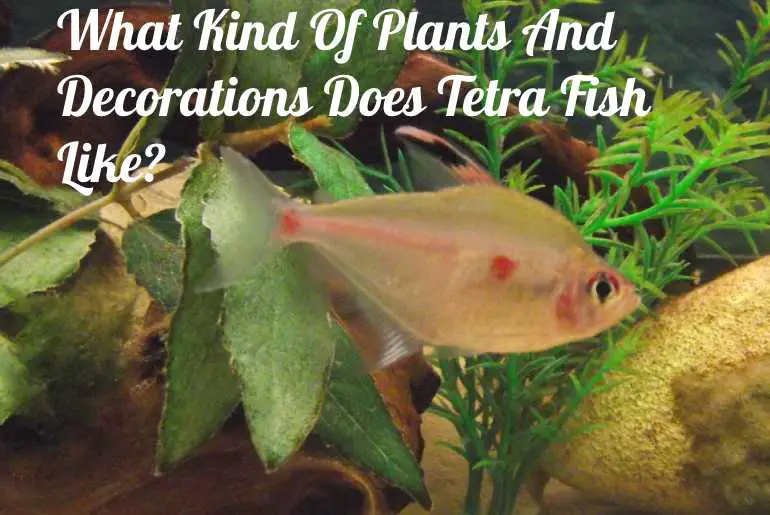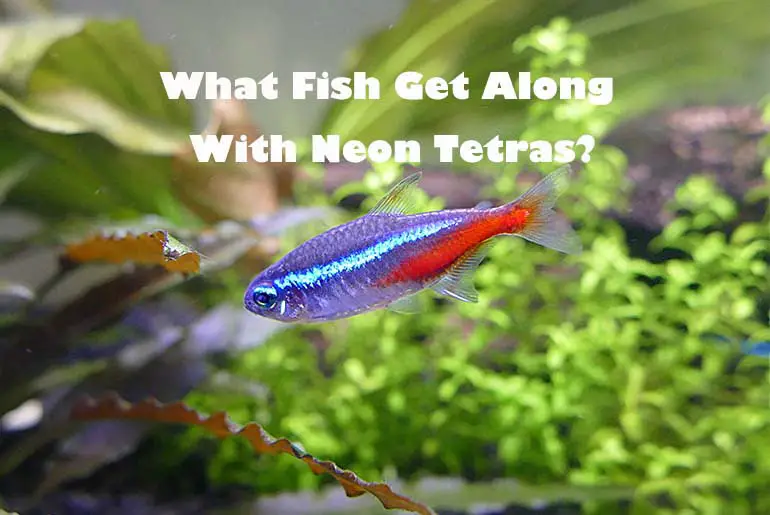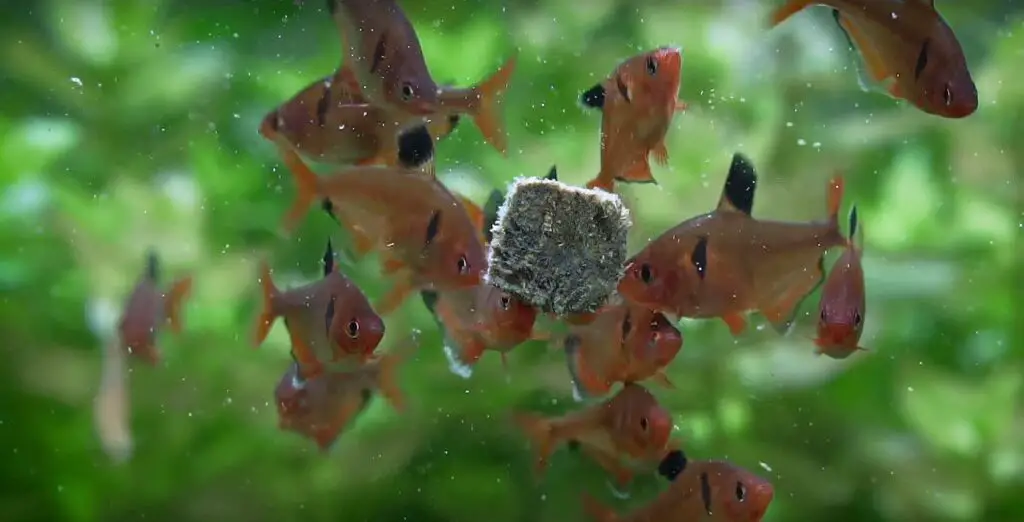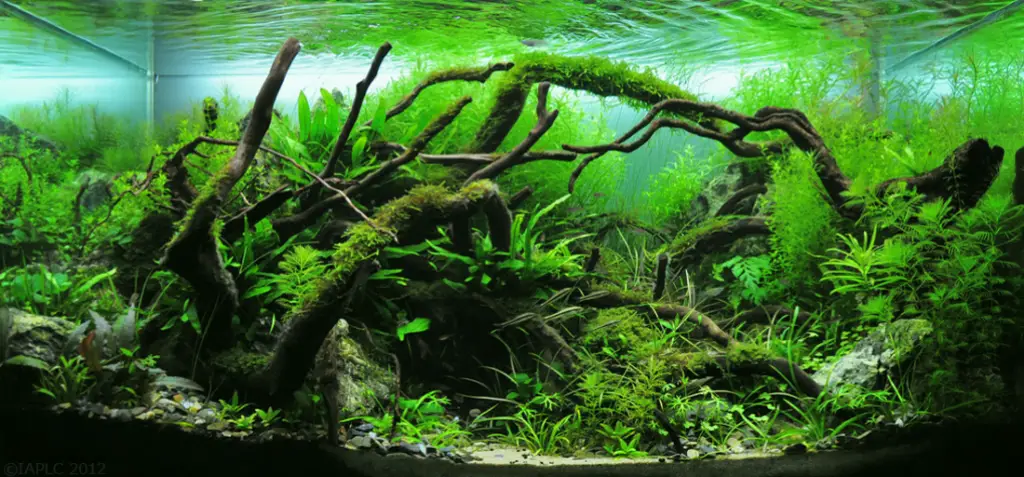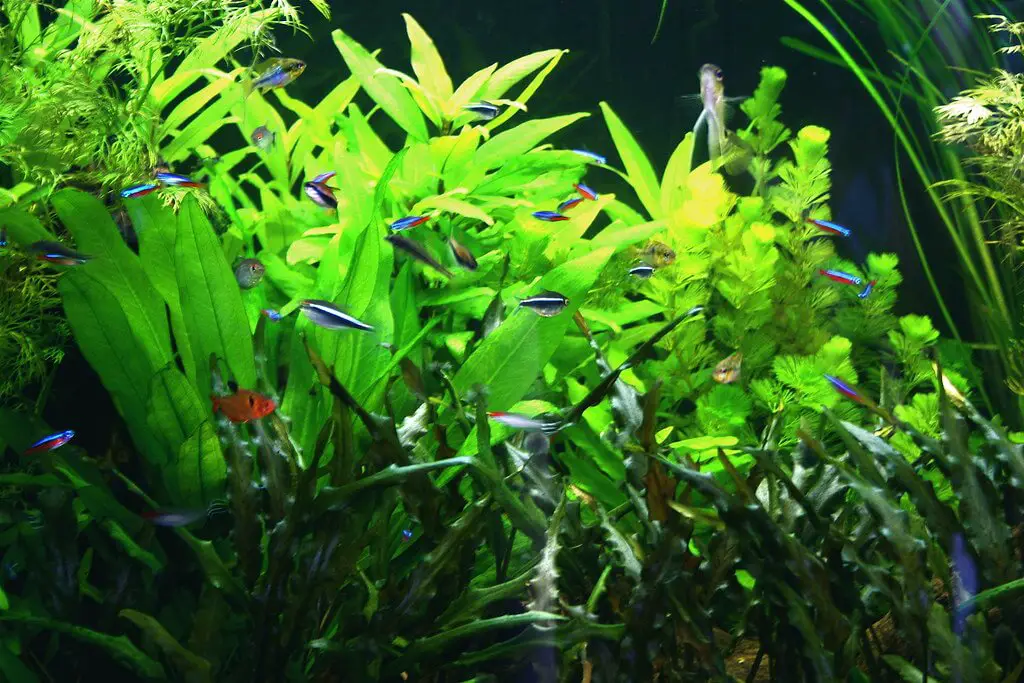Are you a fish lover just like me? Well, if so, don’t you agree that Tetras are one of the popular freshwater aquarium fish lately? The care level of this fish is easy as well. But what about the plants and decorations for your tetras in the tank? I’ve seen many beginner fish hobbyists curious to know about, What kind of plants and decorations does Tetra fish likes? What kind of plants and decorations are harmful to the Tetra fish?
Tetra fish prefers dense floating or cover plants, bottom plants, and plastic aquatic plants too. Those plants will help to balance the adequate Ph level in the tank. Furthermore, Tetras will feel like home if you add the plants according to their preferences.
Just be careful when you choose the plants and decorations for the Tetra fish. We’ll discuss it in full detail later on. Stick till the end.
Overview Of The Tetra Habitat
Tetras belong to the freshwater streams of Africa and Central-South America. Those areas have dense vegetation.
Furthermore, the plants will make the environment naturally darker, as Tetra fish prefer dim lighting. So, make sure to mimic the natural environment when you keep the Tetras in captivity.
What Kind Of Plants and Decorations Does Tetra Fish Like?
Since there are various kinds of Tetra fish available today, the preferences of each species are different.
But most Tetra Fish loves planted tank, so it is your duty to give them what they want. Hence, here are few of the plants for you to choose from.
Live Bottom Plants
Live bottom plants are the best idea for the Tetra fish. Do you know why? It’s because those plants will give a platform for the Tetras to rest and hide peacefully. Remember to make the tank similar to their natural habitat.
Java Moss
Java Moss is native to Southeast Asia and belongs to the Hypnaceae family. It’s one of the easiest aquarium plants to grow.
The care level of this plant is easy and is almost impossible to kill too. Those are the reasons why it’s one of the best plants for the Tetra fish.
Even though Java Moss will benefit in bright light, it isn’t particularly necessary. The Java Moss grows well, especially in damp rocks, gravel, driftwood, riverbanks, and tree trunks too.
Plants that grow on decorations, wow way to go on the like box of tetra fish Java Moss.
Java Moss stays better in soft water. The average suitable water temperature for Java Moss is 59-86 degrees Fahrenheit. The Ph level is 5.0-8.0 too.
If you didn’t know, Java Moss doesn’t have their real roots. It has rhizoids to attach itself to the surface.
In other words, rhizoids are the thin filaments in plants, which will help to absorb the nutrients.
Additionally, Java Moss that grows underwater is smaller than the ones that grow on land. The plants underwater have bright green leaves and irregular-sized branches. Those stems have oval-shaped leaves and appear overlapped.
Uses Of The Java Moss
- Java Moss is used to softening the sandy or rough surface in the tank.
- It’s also famous for Aquascaping (i.e., managing and arranging the aquatic plants and other substrates. It’s similar to gardening but underwater.)
- Java moss is also a platform for the tetra fish to lay eggs. The fry can even hide into these plants to hide from larger fish.
- Mature Java Moss also has a ground for Infusoria (organisms that decompose organic matter) to develop. Infusoria is one of the first food for the new fry.
- Many fish hobbyists use the Java Moss as a floating plant. It’s for the spawning activity of certain fish species.
Java Fern
Java Fern is another popular aquarium plant among fish hobbyists. The scientific name of Java Fern is Microsorum Pteropus. It’s native to Southeast Asia and is from the Polypodiaceae family.
It looks beautiful and popular due to its slow growth, unique shapes, and easy care level. Even a beginner can take proper care of Java Fern.
There are various types of Java Fern available today, as the experts have reproduced many types. The most popular ones are Narrow-leaf, Needle-leaf, Trident, Petite, and Windelov.
Furthermore, Java Fern grows well in soft water. The adequate water temperature for Java Fern is 68-83 degrees Fahrenheit.
The Ph level is 6.0-8.0. Another best thing about this plant is that it’s suitable for any fish. On the other hand, planting Java Fern is super easy as well.
It’ll start to grow even if you throw the plant in the water. The average growth of Java Fern is roughly 10-inches.
So, you can use them as midground or background plants. Moreover, Java Fern doesn’t require too bright lighting as well. Low to Moderate lighting is the best suitable option for Java Fern.
Buying Java Fern is relatively cheap. However, sometimes you could find it already attached to driftwood.
The attached Java fern will be a bit expensive. Not to forget, avoid buying a bunch of these plants.
Even though Java Fern has roots, the rhizomes absorb nutrients from the water. It doesn’t mean that Java Fern isn’t root-feeders.
Uses Of Java Fern
- Java Ferns make a beautiful decoration for the tanks depicting a natural environment. It can be a territory separator as well.
- Tetras swim a lot through Java Fern.
- Java Fern is also a comfortable place for hideout and rest.
- It absorbs some excessive Nitrates(NO3) and Phosphate to keep the water clean and healthy.
- These plants will not eliminate you for water changes. Instead, it balances the water parameters to the desired levels as even herbivores don’t consume Java Fern.
Vallisneria
Vallisneria originates from the tropical and subtropical regions of Asia, Africa, Europe, North America, and Australia.
It’s commonly known as Tape grass/ Vallis and Eelgrass. Vallisneria belongs to the Hydrocharitaceae family and is a flowering plant with 16 known genera. Furthermore, there are 135 known species available today.
Moreover, Vallisneria is a freshwater plant that is submerged deep underwater. It has ribbon-like leaves, which is bright green.
The shape and size of Vallisneria depend upon the specific species. You need not plant a bunch of Vallisneria.
It will spread and grow wide, even if you have one. Species of Vallisneria are suitable for background placement.
Some of the most popular species of Vallisneria are Vallisneria Americana(Gigantean), Vallisneria Nana, Corkscrew Vallisneria, Vallisneria Spiralis, etc.
Another thing about Vallisneria is that it dwells well in both soft and acidic water. The average water temperature that best suits the Vallisneria is 68-82 degrees Fahrenheit.
Furthermore, the ideal Ph level is between 6.0-8.0. The tank conditions of Vallisneria and Tetra are similar, so it’s one of the best plants for Tetras.
Vallisneria is also one of the easiest plants to grow, which is getting more popular lately. It’s a root feeder, which means it’ll absorb the nutrients directly from its roots.
One single plant has either male or female flowers. These plants require bright lighting to grow.
It’ll grow faster up to the surface of the tank in search of light. It’s a good thing because these plants will form dense vegetations in the tank.
Uses Of Vallisneria
- Vallisneria is famous for its medicinal purposes in the treatment of Leucorrhoea and various diseases.
- It can spread vegetation in the tank by spreading widely, providing a home to the Tetras.
- The rapid growth of Vallisneria helps to purify the water.
Amazon Sword
An Amazon Sword is a beautiful freshwater aquarium plant. It’s native to the Western Hemisphere from the Central United States to Argentina(Amazon River Basin).
It belongs to the Alismataceae family. The scientific name of Amazon Sword is Echinodorus Grisebachii or Echinodorus Amazonicus.
Amazon Sword is also one of the best plants for Tetra fish due to its similarity in the water parameters.
It’s popular among beginners and fish hobbyists worldwide due to its easy care-level. The Amazon Sword will also create a forest-like effect, which will make the Tetras happy to swim around.
The maximum growth size of the Amazon Sword is 16-inches. Furthermore, it’s best to keep the plant in a 10-gallon tank.
The tank conditions and water parameters required for the Amazon Sword is similar to that of Tetra fish.
The ideal water temperature for Amazon Sword is 60-83 degrees Fahrenheit. Moreover, the Ph level should be between 6.5-7.5.
If the water conditions are balanced, the Amazon Sword will have dark green leaves. However, understand it has a lack of nutrients if you see it dull, browny, or muddy-red color.
Not to forget, the rootstocks(rhizomes) of the Amazon Sword are thick and solid. They are light in color and stay tight to the ground.
Furthermore, the roots spread out widely and work as a substrate. The rootstocks are a vital part of the plant. It’s because the Amazon Sword needs a solid base for it to grow.
Uses Of Amazon Sword
- It’s a beautiful plant that will make a background for the aquarium along with other plants.
- Since the plants are bushy, they will provide resting and hiding places for the Tetras.
- The Amazon Sword can adapt to water changes as well.
- It doesn’t require much care and will add glory to the tank.
Anubias Petite
Anubias Petite is a tropical aquarium flowering plant. It belongs to the Araceae family. It’s also known as Dwarf Anubias, which makes it a perfect bottom plant for Tetras.
It originates from Singapore, which appeared in the cultivation at the Oriental Aquarium Plant Nursery.
This plant is also the best option for the mid-ground and background substrate. It’s ideal for mini landscapes in the aquarium.
The growth of the Anubias Petite is slow. The care level of this plant isn’t difficult. It’s popular amongst beginners too.
However, maintaining the plant to be healthy might be an issue due to its slow growth. The average growth of Anubias Petite is 3-inches.
This plant has round-shaped dark and vibrant green leaves, which will make your tank look beautiful.
Anubias Petite has a strong root base, which makes it easier to grow in gravel too. Additionally, this plant doesn’t require too much light for their growth as well.
Bright lighting will introduce high algae growth to this slow growth fish. The suitable water parameters for Anubias Petite is similar to that of Tetras.
The adequate water temperature is 72-82 degrees Fahrenheit. Also, the required Ph level is between 6.5-7.5.
On the other hand, the Anubias Petite can adjust itself to the slightly changing water parameters as well.
However, a high range will kill the plants too. Furthermore, The rhizomes are longer than the actual size of the leaves. The plant will die if you bury the rhizome underneath the base.
Uses Of Anubias Petite
- Suitable as a base carpet for large aquariums and a plant substrate for small aquariums.
- Tetras can use the leaves as a hiding and resting place.
- Some Tetras can even nibble a little bit of Anubias Petite.
- The Anubias Petite is suitable for any freshwater, tropical fish.
Live Floating Plants
You already know that the Tetra fish prefer dim lighting in their tank. So, you might already guess they like such plants that will help the aquarium to be naturally darker. Yes, Tetras prefer the floating plants, which will filter minimum light to the tank. It’s because the bottom plants might need some lighting as well. Some of the live floating and cover plants are as follows:
Frogbit
Frogbit is an attractive floating aquatic plant. The scientific name of Frogbit is Limnobium Levigatum. It belongs to the Hydrocharitaceae family.
Frogbit is originally from England and parts of Asia. It belongs to the Hydrocharitaceae family.
The common names of Frogbit are West Indian Spongeplant, South American Spongeplant, and Amazon or smooth Frogbit.
Frogbit looks like a small water lily and blooms during July and August. They have rosettes of smaller, kidney-shaped leaves, which surrounds a three-petalled, white flower with a yellow center.
Furthermore, Frogbits grow faster. You can notice that a new leaf will grow in every 2-days. The leaves will separate from the mother plant to grow into a new plant again.
As it grows too fast, you’ll be able to see more than triple the amount of the plants in about 2-3 weeks.
Moreover, Frogbits can grow up to 20-inches, and they spread widely all over the surface of the aquarium.
The care level of the Frogbit is easy. However, make sure that the water doesn’t touch the top surface of the plant.
It’s because the water may begin to rot the leaves of the plants if water gets above the surface of the plants.
Mature plants will automatically grow above the water, though. The adequate water temperature for the Frogbits is between 64-84 degrees Fahrenheit.
The Ph level should always balance between 6.0-7.5. It means that the Frogbits require soft to moderate water temperature.
Additionally, being a floating plant, Frogbits don’t require excessive lighting. It can grow in low-light tanks as well.
Uses Of Frogbit
- Frogbits is famous as an ornamental aquarium plant.
- These plants provide a shadowed environment, just like Tetra likes.
- Frogbits also help to remove excess nitrates from the aquarium.
Duckweed
Duckweeds are one of the best aquaria freshwater floating plants for beginners. The scientific name of the Duckweed is Lemnoideae.
Duckweed is also commonly known as water lentils or water senses. These plants just float on or just beneath the surface of the water.
Furthermore, Duckweeds can grow both in slow-moving or still water bodies as well. It grows fast and produces offspring rapidly too. It’s also famous as the smallest flowering plant in the aquarium.
Moreover, Duckweeds can also be a food source for some aquatic animals. These plants are also useful for bioremediation of the water with excess phosphorus and nitrogen.
So, Duckweeds are natural fertilizers. The Duckweeds grow from 2-5 mm in size. Duckweeds grow fast in high lighting and slower in lower water temperatures.
So, the growth level of Duckweeds depends upon the water temperature and the sunlight. The nutrients in the water don’t contribute much to their growth.
The care level of Duckweed is easy. As you already know, these plants need high lighting. Even though the Duckweeds are floating plants, these prefer high lighting.
The adequate water parameter for Duckweeds is between 42-91 degrees Fahrenheit. The Ph level should always be from 5-9.
The water parameters may be close enough similar to that of Tetras, and these plants can adjust well too.
Uses Of Duckweeds
- It is famous as an aquaria food among the fish species.
- Duckweeds work as natural fertilizers.
- These plants help to remove ammonia and nitrates from the water.
Brazilian Pennywort
The scientific name of Brazilian Pennywort is Hydrocotyle Leucocephala. Its origin is in the wetlands from South Mexico to Northern Argentina.
It is also known as Brazilian Water Ivy or simply Pennywort. It’s a common aquarium plant as it’s available anywhere.
Furthermore, the Brazilian Pennywort is versatile, easy to grow, and easy to care for, even by beginners.
Brazilian Pennywort plant got its name because it has penny-shaped leaves. The leaves are round, dime to half-dollar sized, which grows alternatively along with a vine-like creeping system.
This floating live aquarium plant develops small white flowers when it reaches the surface of the water.
Tetras especially love this plant because it provides shadow to them, just how they want it to be.
The fry love to play and swim around the leaves of this plant. It’s why the Brazilian Pennywort is one of the best plants for Tetras.
Furthermore, Brazilian Pennywort is similar to another marsh plant named Cardamine Lyrata (also known as Japanese Cress).
The only difference is that the Cardamine Lyrata grow comparatively slower and needs more care too.
The Pennywort requires enough lighting in the aquarium. Well, the plant will receive the light it requires through direct sunlight too.
But, it’ll be good to keep a lighting system inside your tank. Not only that, but this plant prefers lots of nitrogen as well.
These two factors will help the plant to grow faster(a couple of inches per week) and healthier.
Else, the Pennywort will not grow as much as you would expect. The adequate level of water temperature for the Brazilian Pennywort is 68-82 degrees Fahrenheit.
The Ph level for this plant should be between 6-7.8. You can use any size of tank for this plant, but it will continue to grow fast and take over space.
Uses Of Brazilian Pennywort
- It’s the best plant for beginners due to its easy care level and growth.
- Tetras can use the leaves of this plant to hide and swim around as they love the ambiance of Brazilian Pennywort.
- It’s famous as a substrate or bottom plant too. It’ll look beautiful as a background plant.
- This plant helps to clear out the excess nitrogen from the aquarium.
- The Pennywort encourages the growth of infusoria (single-celled organisms or protozoans), which is one of the foods of Tetras.
What Kind Of Plants And Decorations Does Tetra Fish Like? – Artificial(Plastic) Aquarium Plants
Besides the live bottom and floating/cover plants, plastic aquatic plants can’t go wrong either. Firstly, let me be clear. Go for the use of plastic aquatic plants if you’re an experienced fish hobbyist. Don’t jump directly into plastic plants if you’re a beginner.
Pros Of Artificial(Plastic) Aquarium Plants
Nevertheless, there are various benefits of using plastic plants in your aquarium. Not being the live plants, you need not bother about the water parameters for the plastic plants.
Moreover, the cleaning of plastic plants is easy. You just need to take out the plants and rub/ scrub off with a brush, algae pad or spray with the showerhead.
You don’t have to fear for the plants to die either. You should not add additional substrates for the plastic plants too. These plants don’t require fertilizers, lighting, or even CO2. Isn’t it great?
Cons Of Artificial(Plastic) Aquarium Plants
Setting up an artificial plastic aquarium isn’t as hard as setting the live aquarium is. Although, as I said earlier, beginners must not go for it.
One should have experience with the live plants’ aquarium too. It’s because some plastic plants might harm your sensitive fish like Tetra.
As simple as it is, plastic plants don’t absorb carbon dioxide and nitrates nor provide oxygen to the fish.
Additionally, Tetra fish love to eat algae too, and artificial plants don’t allow and support the growth of Tetra. In other words, artificial plants don’t have any biological value for the fish aquarium.
Keep The Plants Healthy
After you set up your tank from all the plants, you shouldn’t forget to keep them healthy too.
Cleaning won’t be hard if you’ve artificial plants. But, keeping the live plants won’t be a problem if you’ve live plants.
However, I’m not trying to scare you. You must analyze the nature of the plants that you keep. Then, you need to maintain the plants as per their requirement.
Change And Remove The Plants If Necessary
The main task after keeping the plants is to maintain them. As every plant have their nature, you must change and remove the plants too.
Some plants need extra care, while some might not. Change and remove the decayed or dead plants on time to decrease the chances of an increase in wastage.
Fertilize The Plants
Proper Fertilization of the live plants is an essential factor in an aquarium. It’s because the plants and the fish are bound in a limited space.
When Tetras produce excess waste, you must change the water every once in a while. But what about the plants?
Yes, the live plants will help to clear up the dirty environment by observing either nitrogen, nitrites, and carbon dioxides. However, you must not forget that the plants need the required level of care too.
Although there are plants that will live for too long and don’t require much care, you must still not be careless.
Various plants require some level of care, as well. There are fertilizers available in the market for such plants. But let me warn you.
One fertilizer may not be suitable for every plant and fish that you keep. Check the name and brand of the fertilizer and the uses of it before buying one.
What Plants Should You Avoid For The Tetra Fish?
You know about what kind of plants and decorations does Tetra fish likes. So, you must also know about the plants you should avoid.
Some Tetras may just love to eat some sort of plants. You may not like it if you have spent a fair amount of your time to cultivate those plants, isn’t it?
Not only that, you wouldn’t love to hear that some plants may even hurt your fish. Those plants may die and even lead your fish to stress out.
Even though the bright and vibrant foliage may add interest and appeal to your tank, it may not be the best choice for Tetras.
Furthermore, emerged water plants are also not suitable for Tetras in an aquarium. The water parameters and their nature may not match.
Whenever you think of buying a specific plant, you must check the details of it. Every plant is different from each other. While some may be useful for the Tetras, some might be harmful too.
Will Too Many Plants Kill The Tetra Fish?
Well, anything more than necessary is harmful to everyone or anything in the world. That’s the reason why you should balance the number of plants for the Tetras too.
Being sensitive being, these fish prefer living in a comfortable environment. Yes, mimicking the natural environment of the Tetras is essential. However, it doesn’t mean that you’ll add too many plants to the aquarium.
So yes, keeping too many plants in the aquarium will stress or even kill the Tetra fish. Just keep enough plants to balance the water temperature and to provide enough vegetation to the Tetras.
Decoration And Substrates
We are continuing to talk about what kind of plants and decorations does Tetra fish likes. You already know about the Aquarium Plants For Tetra Fish, we’ve now reached the part of decoration and substrate.
Besides plants, Decoration and Substrates also plays a vital role for the Tetras, especially in captivity.
Keeping the right decoration and substrates will make the Tetras happy and stress-free. However, the wrong ones might do the opposite. So, be careful. Choose the ones which will mimic the real environment of the Tetras.
Lots Of Hiding Places
Tetras, being peaceful and shy fish, will love to hide a lot behind suitable areas. Not only that, but Tetras hide when they feel insecure and uncomfortable too.
Tetras get scared easily from the fish species larger than them, and hiding is the option they choose.
Tetras are sensitive beings just like we are, and these fish might get sick often as well. So, Tetras require lots of hiding places.
Some of the best substrates for hiding are rocks, gravel, driftwood, caves, etc. The darker ones, which will make the tank to be naturally darker, are the best suitable options.
Swimming Space
If you didn’t know, Tetras love to swim around the tank. Some are fast swimmers. All you have to do is to ensure that they have enough space to swim around comfortably.
Like the fish experts have said, per-inch of fish require one-gallon of water. Even if you keep the number of Tetras according to the size of your tank, it’s essential to give them adequate space.
Tetras will stress out fast if they don’t get the space they require. Leave some extra space after you keep the plants and substrates as well.
Lighting, Heating, And Filtration
Other vital parts for both the plants and the Tetra fish are lighting, heating, and filtration. You already know that the Tetras don’t prefer bright lighting.
So, you’ll choose the best suitable plants which don’t require bright lighting as well. Bright lighting may harm both the fish and the plants.
Moreover, heating is another essential part of plants and fish. Some plants and Tetras have a similar choice in the water temperature.
Thus, keep a water heater to balance the water parameters so that it doesn’t affect them.
Lastly, proper filtration is the most crucial thing for the fish, especially in captivity. The plants may help to reduce some level of excessive wastage.
But, it’ll not be enough as the waste won’t have a way of its own to leave the aquarium. So, keeping a proper filtration system is necessary to keep the tank clean and healthy.
Conclusion- Plants and Decorations For Tetra Fish
Now that we’ve reached the end of this article, you know what kind of plants and decorations does the Tetra fish like, don’t you? Well, choosing the exact plant which Tetra likes may be a little difficult task. But since there are too many options available, I guess it may not be too difficult as you think.
You must remember the nature and behavior of the Tetras before choosing the plants. It is essential because your fish should comfortable and not stressed out at all. Choose the plants and decorations that best suit your Tetra Fish and add more glory to your aquarium too. I hope you succeed in making your Tetras happy with the plants and decorations they love! Good luck and happy fish keeping!
Recommended Articles:
- How to Set up an Aquarium for Tetra Fish
- 4 Step Process on How To Keep Tetra Fish Happy And Healthy –
- How Often Should I Clean My Tetra Fish Tank?
